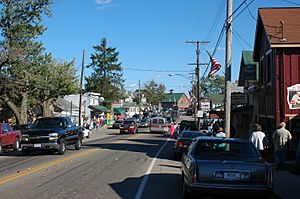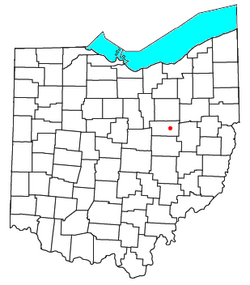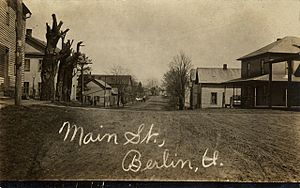Berlin, Holmes County, Ohio facts for kids
Quick facts for kids
Berlin, Ohio
|
|
|---|---|

Downtown Berlin
|
|

Location of Berlin, Ohio
|
|
| Country | United States |
| State | Ohio |
| County | Holmes |
| Township | Berlin |
| Area | |
| • Total | 3.83 sq mi (9.91 km2) |
| • Land | 3.82 sq mi (9.89 km2) |
| • Water | 0.01 sq mi (0.02 km2) |
| Elevation | 1,227 ft (374 m) |
| Population
(2020)
|
|
| • Total | 1,447 |
| • Density | 378.89/sq mi (146.31/km2) |
| Time zone | UTC-5 (Eastern (EST)) |
| • Summer (DST) | UTC-4 (EDT) |
| ZIP code |
44610
|
| Area code(s) | 330 |
| FIPS code | 39-05816 |
| GNIS feature ID | 2628864 |
Berlin is a special kind of community in central Holmes County, Ohio, United States. It's called a census-designated place, which means it's a community that isn't officially a city or town, but it's still recognized for counting people.
As of 2020, about 1,447 people live in Berlin. This area is famous for being in the heart of Ohio's Amish Country. Because of this, Berlin is a very popular place for tourists to visit!
Contents
Exploring Berlin's Past
Berlin is the oldest village that still exists in Holmes County. It was first planned on July 2, 1816. A man named John Swigert, who was from Berlin, Germany, created the first layout for the village. His plan included 108 lots arranged along two main streets.
Another early settler, Joseph Troyer, came from Berlin, Pennsylvania. Together, Swigert and Troyer decided to name the new settlement "Berlin" after their hometowns. Berlin is located on a high point in Holmes County.
Who Were the First Settlers?
Many of the first people who settled in the Berlin area came from Pennsylvania. They often had German or Swiss family backgrounds.
Growth and Development
Berlin grew steadily over the years. In 1818, the community opened its first school. A few years later, in 1822, a post office was established. Soon after, different churches were built, including Methodist, Presbyterian, Baptist, and Mennonite churches. Later, Amish settlers also began to arrive in the area.
During the 1800s, Berlin became a busy place for business and industry. It had places like machine shops, a foundry (where metal objects are made), blacksmith shops, and even a hat factory. There were also hotels, an auction house, and many different stores. In 1833, Berlin was described as having 21 homes, two stores, two taverns, and a doctor.
Today, Berlin is at the center of Ohio's largest Amish community. It is home to the Amish and Mennonite Heritage Center. This center features a special display called "Behalt," which tells the story of Amish and Anabaptist history. Ohio has about 56,000 Amish residents, and this number has grown a lot since 1992.
Where is Berlin Located?
Berlin is in the eastern-central part of Holmes County. It's located where two main roads meet: U.S. Route 62 and State Route 39.
- US-62 goes northeast about 11 miles to Wilmot.
- State Route 39 goes southeast about 10 miles to Sugarcreek.
- If you follow both highways west, you'll reach Millersburg, which is the main town for Holmes County, about 7 miles away.
Berlin is located at a specific point on the map: 40 degrees, 33 minutes, 40 seconds north (latitude) and 81 degrees, 47 minutes, 40 seconds west (longitude). The ZIP code for Berlin is 44610. The elevation, or how high it is above sea level, ranges from about 1,200 to 1,280 feet.
Berlin's Economy and Tourism
Berlin is a very popular place for tourists visiting Ohio's Amish Country. Even though its permanent population is smaller, it attracts more visitors than any other town in the area. Berlin was one of the first towns in Ohio to welcome tourists interested in the Amish way of life.
A Hub for Visitors
Berlin's business area is quite large. As of 2012, it had more than 40 shops, 10 hotels, and many different restaurants. A researcher named Susan L. Trollinger has described Berlin's buildings and shops as "eclectic," meaning they are a mix of different styles. However, they often remind people of the American frontier or the 1950s. She notes that Berlin, like other towns in the area, often looks back to the past.
Trollinger also suggests that the "frontier" theme in Berlin tells a story of peaceful people. It shows them leaving crowded cities to build a better life for themselves and their families. The community is also home to the Amish and Mennonite Heritage Center, which is a big draw for visitors.
Famous People From Berlin
Some well-known people have connections to Berlin:
- Atlee Pomerene – A U.S. senator.
- Nate Torrence – A television actor.
- Alta Weiss – An early female baseball player who played semi-professionally.
See also
 In Spanish: Berlín (Ohio) para niños
In Spanish: Berlín (Ohio) para niños


